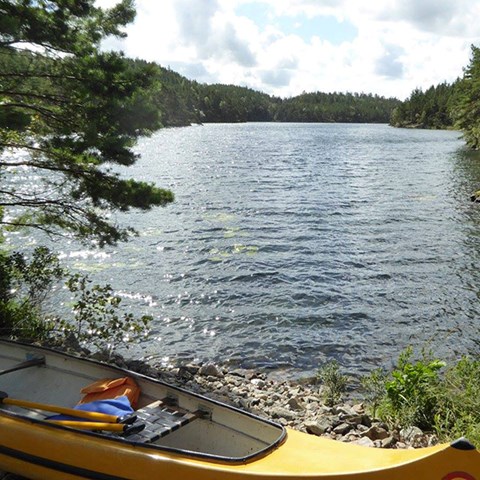Worrying discovery of nanoplastics in remote forest waters

Nanoplastics – tiny, invisible plastic particles that could hardly be measured previously – have now been detected in high concentrations in lakes, streams and ponds in Sweden, and also in unpopulated areas in Siberia. Nanoplastics are so tiny that they can cross the cell membranes of living organisms. The results were recently published in Environmental Research Letters by researchers from Utrecht University in collaboration with, among others, SLU.
Microplastics, which are particles less than 5 mm in size, are found in soils and waterbodies across the globe. These microplastics can fragment into even smaller particles known as nanoplastics. Nanoplastics are so small that they can cross the cell membranes of living organisms and interfere with cellular functioning, and are therefore a real risk to environmental and human health. Because nanoplastics are so small, measuring them accurately has, until recently, been almost impossible, and it is therefore unknown how widespread they are in the natural world.
An international team, led by scientists, successfully measured nanoplastic concentrations in lakes, streams and ponds in Sweden and Siberia. The Swedish sampling took place at the Gårdsjön Research Catchment, a long-term monitoring site that has been used for more than 40 years by scientists from Sweden and elsewhere to understand and manage environmental pollution. Gårdsjön is a forested landscape, with no houses or agriculture, yet nanoplastics were found in all samples. The Siberian samples were taken from ponds and lakes in a remote tundra landscape, where the nearest small settlement was 30 km away, and the nearest city 1200 km away. Nanoplastics were detected in seven of the twelve Siberian samples, although concentrations were lower than the Swedish samples.
At Gårdsjön four different plastic polymers were found (polyethylene, polyvinyl chloride, polypropylene, and polyethylene terephthalate) with the highest concentrations found for polyethylene. This is the most common plastic used in Europe, and large volumes of it are used for single-use packaging materials which are subsequently disposed. These plastics could come from a range of common source materials, or possibly via nearby industrial emissions or further afield in north-western Europe. In Siberia only two plastics, polyvinyl chloride and polystyrene, were detected. It is possible that these plastics were deposited by occasional visitors, researchers or hunters, to this remote location, but in the wider region (within several hundred km) there are abandoned mining stations which could also be potential sources.
Dr Dušan Materić of Utrecht University developed a state-of-the-art analytical method, using a technique called Thermal Desorption Proton Transfer Reaction Mass Spectroscopy, to measure the nanoplastic concentrations. He said: “Measuring plastics this small is incredibly challenging. These particles are so tiny and all mixed together with other environmental particles. To detect them, we slowly heat up the prepared samples and measure the plastic-specific vapours; essentially, the “smell” of the plastic. This way, we can learn a lot about different types of plastic and their concentrations, and therefore how widespread they are in the environment. This is really important to know because a growing body of evidence suggests that nanoplastics are far more dangerous than microplastics, which we understand quite a lot about now.”
Because both the Swedish and Siberian waterbodies were in rural and remote areas, with no towns, industry or agriculture on their shores, Dr Materić and colleagues think that the nanoplastics must be being released from distant cities, and then transported for hundreds or thousands of kilometres through the atmosphere. There is therefore the potential for nanoplastics to be present in lakes, ponds, streams and rivers across the entire planet, even in unpopulated regions.
Dr Mike Peacock at the Swedish University of Agricultural Sciences collected the Swedish samples. He said: “Our results are profoundly shocking. To collect these samples we kayaked across quiet lakes, and hiked through empty forests. There’s no sign that the landscape is degraded in any way. But then our results show that these beautiful ecosystems are actually full of invisible, human-produced, plastic waste, which is a depressing realisation.”
Although the results from this new study are concerning, the authors emphasize that their work isn’t all doom and gloom. Dr Martyn Futter from the Swedish University of Agricultural Sciences was also involved in the research. He said: “We know that plastic pollution is of global concern. If we are to reduce plastic pollution, we need the right tools so future changes can be measured. Our work is a first stepping stone towards understanding and managing this invisible danger to ourselves and the natural world.”
Contact person at SLU
Michael Peacock, Researcher
Department of Aquatic Sciences and Assessment; Section for Geochemistry and Hydrology
Swedish University of Agricultural Sciences, Uppsala
michael.peacock@slu.se
https://www.slu.se/en/ew-cv/michael-peacock2/
The article
Dušan Materi et al. 2022. Presence of nanoplastics in rural and remote surface waters. Environ. Res. Lett. 17. https://doi.org/10.1088/1748-9326/ac68f7